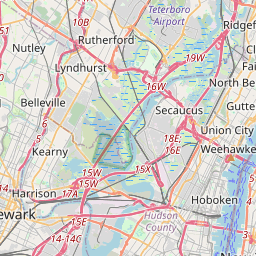Boyhood Home of Bret Harte
Historical marker location:
487 Hudson St, New York, New York
( Marker is at the intersection of Hudson Street and Grove Street, on the left when traveling north on Hudson Street.)







© OpenStreetMap contributors
Loading...
Searching for other points of interest within 3 miles of this location.The first African-American woman to earn a medical degree in the United States, Dr. Rebecca Lee Crumpler, studied at the New England Female Medical College in Boston, but she completed her clinical studies at the New York Infirmary for Women and Children in Manhattan in 1864.
About New York County
New York County Timeline
New York County, also known as Manhattan, has a rich and diverse history that dates back centuries. The area was first inhabited by the Lenape Native American tribe before becoming a Dutch settlement called New Amsterdam in the early 17th century. In 1664, the British seized control of the area and renamed it New York after the Duke of York. Throughout the colonial era, New York grew in importance as a major trading hub.
Following the American Revolution, New York County flourished as the country expanded westward. It became a magnet for immigrants from around the world, with the iconic Statue of Liberty serving as a symbol of hope for those seeking a better life in America. The county saw rapid urbanization and the construction of skyscrapers, giving birth to the modern city we know today.
In the 20th century, New York County became the cultural, financial, and political center of the United States. The Harlem Renaissance in the 1920s brought a wave of African American art, music, and literature, showcasing the county's diversity. The Great Depression had a significant impact on the area, but it rebounded during World War II with a booming economy.
In recent years, New York County has continued to thrive as a global economic hub and a cultural melting pot. It has faced various challenges, such as the September 11 terrorist attacks in 2001 and the ongoing issues of income inequality and gentrification. However, New York County remains an iconic and vibrant destination, attracting millions of visitors each year and serving as a symbol of the American dream.
Following the American Revolution, New York County flourished as the country expanded westward. It became a magnet for immigrants from around the world, with the iconic Statue of Liberty serving as a symbol of hope for those seeking a better life in America. The county saw rapid urbanization and the construction of skyscrapers, giving birth to the modern city we know today.
In the 20th century, New York County became the cultural, financial, and political center of the United States. The Harlem Renaissance in the 1920s brought a wave of African American art, music, and literature, showcasing the county's diversity. The Great Depression had a significant impact on the area, but it rebounded during World War II with a booming economy.
In recent years, New York County has continued to thrive as a global economic hub and a cultural melting pot. It has faced various challenges, such as the September 11 terrorist attacks in 2001 and the ongoing issues of income inequality and gentrification. However, New York County remains an iconic and vibrant destination, attracting millions of visitors each year and serving as a symbol of the American dream.
New York County Timeline
This timeline provides a condensed summary of the historical journey of New York County, New York.
- 1624 - The Dutch establish the colony of New Amsterdam on the southern tip of Manhattan Island
- 1664 - The English capture New Amsterdam and rename it New York
- 1683 - New York County is established as one of the original 12 counties of New York
- 1785 - The Commissioners' Plan of 1811 is implemented, laying out the street grid for most of Manhattan
- 1790 - New York becomes the temporary capital of the United States
- 1825 - Construction of the Erie Canal is completed, connecting New York City to the Great Lakes
- 1898 - New York County is consolidated with the four other boroughs to form the City of Greater New York
- 1904 - The first subway line in New York City opens, connecting Manhattan with Brooklyn
- 1929 - The Wall Street Crash triggers the Great Depression
- 1957 - The New York Yankees baseball team moves from the Bronx to Manhattan
- 2001 - The September 11 attacks on the World Trade Center devastate Lower Manhattan